Ask a TESOL Leader: "How can professional development be helpful in improving the teaching and learning process?"
by Raichle Farrelly
Question: "How can PD be helpful in improving the teaching and learning process?"
In my view, the primary goals of professional
development [PD] are to promote professional learning, create a community of
practice, and, ultimately, enhance learning outcomes for students and programs.
PD can provide educators with new techniques, strategies, and evidence-based
practices to elevate the teaching and learning experience. PD can also create
conditions that support educators holistically on social and emotional levels,
which is important because—arguably—a well-balanced, fulfilled educator has
greater capacity for engaging learners through meaningful instructional
practices.
Among TESOL’s
6 Principles for Exemplary Teaching of English Learners®, Principle
6 is “Engage and collaborate within a community of practice” (CoP).
For me, community is a driving force in my life, both personally and professionally,
so I seek out opportunities to learn with and from others. As humans, we’re not
meant to live and work in isolation, so we inherently seek out relationships
that enhance our lives.
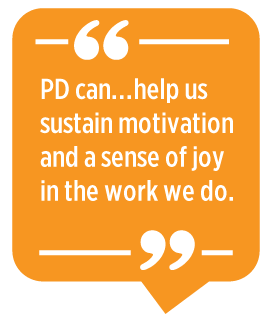 In many ways, PD can provide us with the personal and
professional connections that help us sustain motivation and a sense of joy in
the work we do, which extends to the students we share learning spaces with. A
CoP can provide the socioemotional support that fuels us when we’re feeling
isolated, frustrated, or simply burned out. Of the PD options that foster
deeper connections, some of my favorites include study circles, lesson
study, peer
coaching, and collaborative sessions at conferences (e.g., workshops,
discussions, and poster sessions).
In many ways, PD can provide us with the personal and
professional connections that help us sustain motivation and a sense of joy in
the work we do, which extends to the students we share learning spaces with. A
CoP can provide the socioemotional support that fuels us when we’re feeling
isolated, frustrated, or simply burned out. Of the PD options that foster
deeper connections, some of my favorites include study circles, lesson
study, peer
coaching, and collaborative sessions at conferences (e.g., workshops,
discussions, and poster sessions).
Study circles (my top choice for teacher-led,
inquiry-based PD) are great because they intentionally infuse research into the
professional learning experience so that participants can connect their
day-to-day practices with scholarly work in their respective fields. The
research can be explored in a format that resembles a book
club; individuals can take turns leading discussions on articles of
their choosing; or, sessions can be more structured (e.g., see this study
circle facilitator’s guide from the National Center for Adult
Learning and Literacy).
I have to sing the praises of our colleagues in
Minnesota, USA at ATLAS
ABE and Hamline University who have created several study circle
facilitator guides that anyone can download and use (see guides linked at the
end of this column). They provide all the resources you need to explore various
topics within adult education. As with any form of PD, you’ll want to adapt the
materials to fit the teaching and learning context and the needs of the
participants, which may mean finding different research articles to read or
adapting certain activities in response to available resources. But don’t try
to re-create the wheel—adapt what these amazing colleagues of ours have already
created!
PD—whether it be in community or an independent
endeavor such as an asynchronous online course or webinar—broadens our skill
set as educators and administrators so that we teach, lead, and mentor using
evidence-based, high-impact practices. In our CoPs, we can find inspiration
from one another. We can debrief failures and explore “blue sky” ideas. We can
gain confidence from the validation and feedback of our peers. And if we’re
fortunate, our colleagues become more than collaborators—they become
friends!
Study Circles from ATLAS ABE
& Hamline University
Do you have a question for the TESOL
leadership? Email your question to tc@tesol.org
with the subject line “Ask a TESOL Leader” and it could be featured in this
column!
Do you have a question for the TESOL leadership? Email your question to tc@tesol.org with the subject line "Ask a TESOL Leader" and it could be featured in this column!
Raichle Farrelly is an associate teaching
professor and director of the TESOL Program at the University of Colorado
Boulder. She offers courses on principles and practices in TESOL, teaching L2
oral skills, pedagogical grammar, and introduction to linguistics. Farrelly
coedited Educating
Refugee-background Students: Critical Issues and Dynamic
Contexts, the Handbook
of Research on Cultivating Literacy in Diverse and Multilingual
Classrooms, and Continuing
Professional Development of TESOL Professionals: A Global
Landscape.
TESOL Blogs
Interested in writing a blog for TESOL?
Read the submission guidelines and send us your post!
Check out some of the most recent TESOL Blogs:
|
Tackling Complex Written Texts: 5 Strategies to Scaffold Reading, by Naashia Mohamed
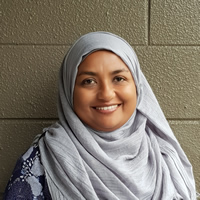
Imagine the following scenario: Riku is a 14-year-old multilingual learner of English in secondary school in New Zealand. Although he can read simple texts, he is not yet able to tackle the more complex texts used for teaching in most of his Year 10 classes. Riku mostly understands the teacher’s explanations in class but he struggles to make sense of written texts and feels frustrated that he is not able to follow along. He spends a lot of time trying to comprehend each word in a text, using bilingual dictionaries and online translators, but this slows him down considerably. This week, in science he is learning about the atmosphere and our climate. The teacher has planned for the class to research how the changing climate is affecting us and has several print and online resources available to students.
If you were Riku’s science teacher, what would you do? Given his challenges with reading, what supports could you offer to make complex texts more accessible to him? Read more. |
|
International Exchange as Professional Development, by Laura Baecher
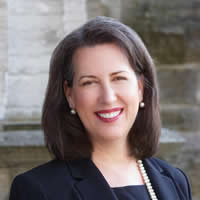
Guest Blogger: Kelli Odhuu
What changed my life? What experience gave me a greater understanding of another culture and my own culture? What experience allowed me greater insight into my students’ learning processes and improved my reflective abilities on my own teaching experience? The year I spent on a teacher exchange.
I received a grant from the U.S. Department of State for the English Language Fellow Program to teach undergraduates in another country. Being a Fellow was the best job I have ever had. I was a teacher to undergraduate students; a mentee of motivated and experienced English teachers; a tourist enjoying the new-to-me culture, food, and language; and an entertainer to the public, who enjoyed hearing me speak on such fascinating topics as English spelling absurdities. Read more. |
|
Reading a Gravel Driveway in Fredericksburg, Virginia, USA, by Spencer Salas

It’s just about the end of summer here in Charlotte, North Carolina, USA and almost time to start a new school year. For this month’s post, I’d like to write about a gravel driveway and reading.
My godparents had a small farm in Stafford County just outside Fredericksburg, Virginia, USA with hogs and chickens and hound dogs. There was a long gravel driveway that led to the two-story red brick house banked by two ditches, where orange lilies bloomed in late spring. In July and August, blackberries grew wild in the fields. We’d pick them for my godmother, who would make pies for us kids. Read more. |
TESOL Bookstore

Featured Resources from TESOL Press
ELT Basics is an invaluable resource for those seeking a straightforward, practical, and foundational understanding of English language teaching. This book covers a broad range of important topics, such as what it means to “know” a language, how people learn new languages, and what teachers can do to teach English effectively. Whether you’re looking for a basic understanding of ELT or considering a career in language teaching but want to know more first, this book will teach you about language acquisition as well as how to plan, instruct, and assess multilingual learners of English.
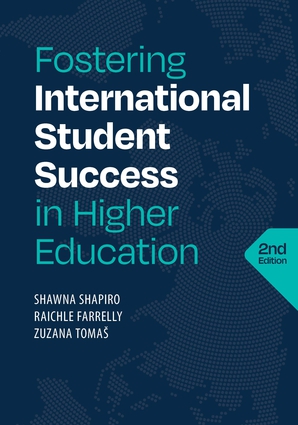 Fostering International Student Success in Higher Education, Second Edition
Fostering International Student Success in Higher Education, Second Edition
Shawna Shapiro, Raichle Farrelly, Zuzana Tomaš
(Copublished by TESOL and NAFSA)
The increase in the number of international students attending English-dominant schools brings benefits as well as challenges for institutions. Shapiro, Farrelly, and Tomaš provide a lively, informative discussion that answers the questions instructors commonly ask when seeking to ensure success for these students: What do I do to help students be successful in U.S. academic culture? How can I ensure that the content for my course is comprehensible to students who are still learning English? How do I design assignments and assessments that are fair while still acknowledging the difficulty of doing academic work in a second or foreign language? How might I treat international students as a linguistic and cultural asset in the classroom, and help them to become institutionally integrated?
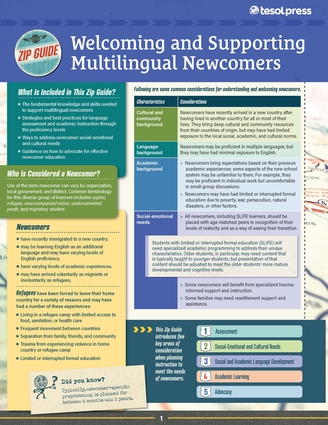 TESOL Zip Guide:
TESOL Zip Guide:
Welcoming and Supporting Multilingual Newcomers
Amber Warren, Melissa Hauke, Jan By Ying Hui-Michael, Adrienne Johnson
Newcomers are students who have recently immigrated to a new country, may be learning English as an additional language, and may have varying levels of English proficiency. This guide introduces five key areas of consideration when planning instruction to meet the unique social-emotional, linguistic, cultural, academic, and programming needs of multilingual learners of English who are newcomers. It includes strategies and best practices for language assessment and academic instruction through the proficiency levels, and guidance on how to advocate for effective newcomer education.